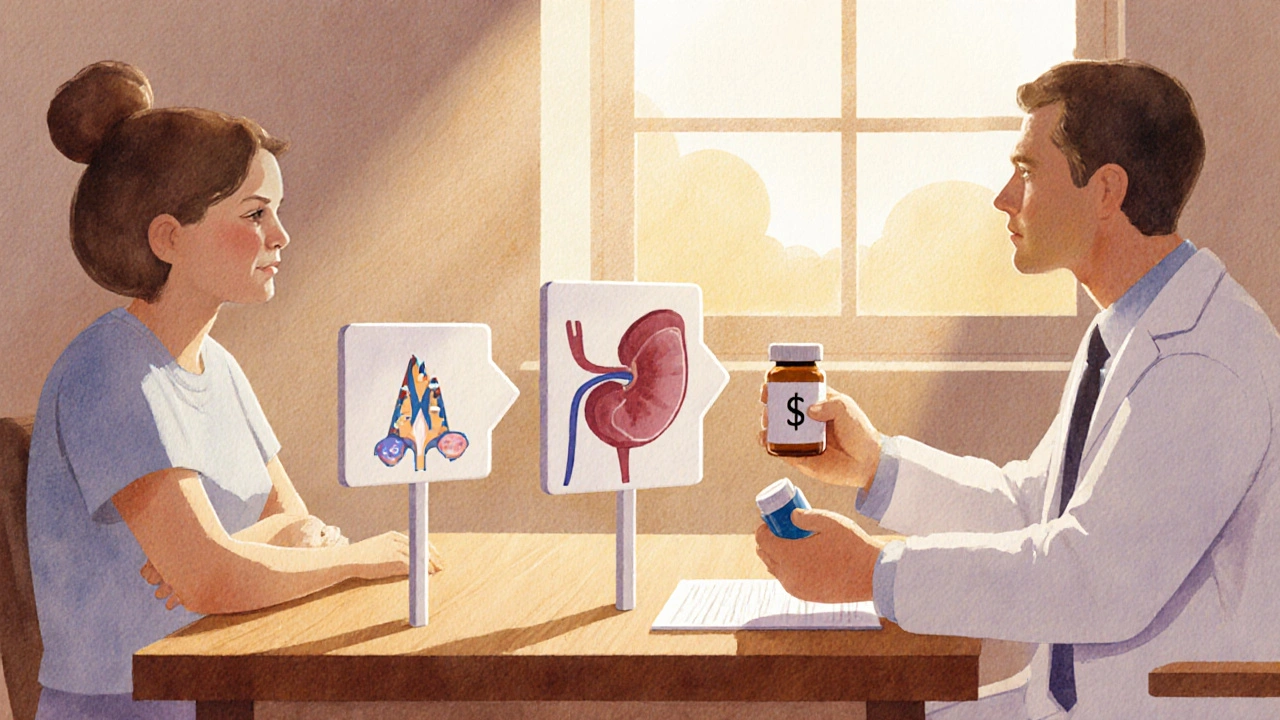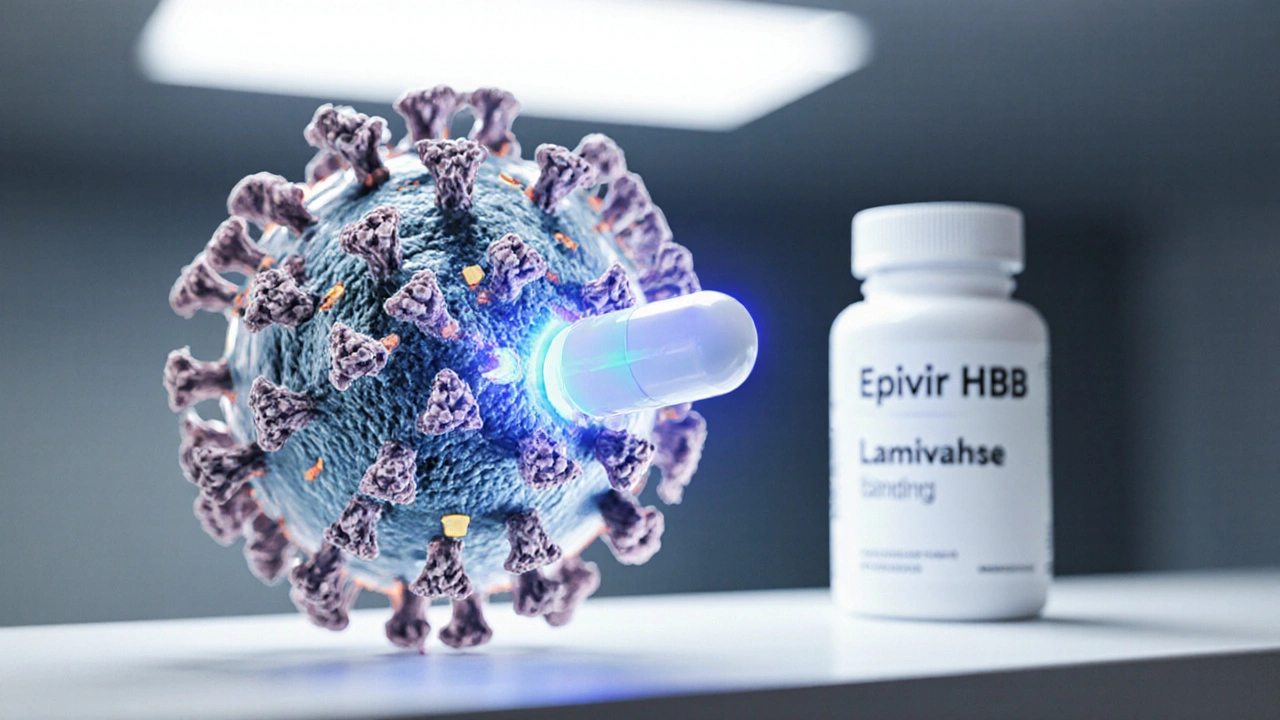Quick Takeaways
- Lamivudine works well but resistance can appear after 2‑3 years.
- Tenofovir (both disoproxil fumarate and alafenamide) offers the lowest resistance rates.
- Entecavir is highly potent with a safety record similar to tenofovir.
- Adefovir is cheaper but less effective for high‑viral‑load patients.
- Choosing the right drug depends on viral load, kidney health, pregnancy plans and cost.
What is Epivir HBV (Lamivudine)?
Epivir HBV is the brand name for lamivudine, a nucleoside analogue that blocks the hepatitis B virus (HBV) polymerase. By mimicking the natural building blocks of DNA, it stops the virus from copying its genetic material, slowing disease progression.
Lamivudine has been on the market since the early 2000s, so doctors know its safety profile well. Typical dosing is 100mg once daily, taken with or without food.
How does Lamivudine compare to other HBV drugs?
In the past decade, newer agents have entered the scene. The big players now are tenofovir disoproxil fumarate (TDF), tenofovir alafenamide (TAF), entecavir, and, for older regimens, adefovir dipivoxil. Each belongs to the broader class of nucleos(t)ide analogues that target the same viral enzyme.
While all these drugs aim to suppress HBV DNA, they differ in three practical areas: how well they keep the virus down (efficacy), how often the virus fights back (resistance), and how they affect your kidneys and bones (safety).
Key Alternatives at a Glance
Below are the most common alternatives you’ll hear about during a clinic visit.
- Tenofovir disoproxil fumarate (TDF) - the first‑generation tenofovir, taken as 300mg once daily.
- Tenofovir alafenamide (TAF) - a newer, low‑dose version (25mg) that delivers the same potency with less kidney stress.
- Entecavir - usually prescribed at 0.5mg or 1mg daily, depending on prior treatment.
- Adefovir dipivoxil - a 10mg daily tablet, now considered a fallback for specific cases.
Side‑by‑Side Comparison
| Drug | Viral suppression rate (12mo) | Resistance after 5yr | Kidney impact | Typical cost (US, monthly) |
|---|---|---|---|---|
| Lamivudine | ≈70% | ≈25% (mutations M204V/I) | Minimal | $10‑$15 |
| Tenofovir disoproxil fumarate | ≈90% | <1% | Potential ↓eGFR, monitor | $30‑$45 |
| Tenofovir alafenamide | ≈92% | <1% | Very low renal & bone impact | $45‑$60 |
| Entecavir | ≈85‑90% | ≈3% if NA‑naïve, higher if pre‑treated | Minimal | $25‑$35 |
| Adefovir dipivoxil | ≈55‑65% | ≈10% | Can affect kidneys at higher doses | $8‑$12 |
When might Lamivudine still be the right choice?
If you’re already on lamivudine and your viral load is low, you might not need to switch immediately. Its low cost and once‑daily dosing make it attractive in resource‑limited settings. Pregnant women sometimes stay on lamivudine because it’s well‑studied for safety during pregnancy.
However, if your latest HBV DNA test shows a rising trend or you’ve been on the drug for more than three years, discuss resistance testing with your doctor. A switch to tenofovir or entecavir can often re‑establish control.
Safety tips and monitoring
All these medications require periodic blood work. For lamivudine, the main focus is liver enzymes and viral load. Tenofovir agents need kidney function checks (creatinine, eGFR) every 6‑12months. Entecavir is generally gentle on kidneys but still warrants regular liver panels.
Side effects are usually mild: occasional headache, nausea, or fatigue. If you experience bone pain or a sudden drop in kidney numbers, alert your clinician right away.

Cost and access considerations
Drug pricing varies by country and insurance coverage. In Australia, lamivudine is listed on the Pharmaceutical Benefits Scheme (PBS), keeping the out‑of‑pocket expense under $20 per month. TenofovirTAF is newer and may not be PBS‑listed yet, so private patients often pay $70‑$100.
Generic versions of TDF have lowered its price dramatically in the past few years, making it a solid mid‑range option for many patients.
How to decide which drug fits you best
- Assess viral load and liver health. High HBV DNA (>2millionIU/mL) usually calls for the most potent agents - TDF, TAF or entecavir.
- Check kidney function. If eGFR is below 60mL/min, lean toward lamivudine or entecavir, or choose TAF which is gentler.
- Consider pregnancy plans. Lamivudine and tenofovir are both Category B, but TAF’s data in pregnancy are still emerging.
- Review insurance or PBS coverage. Lower‑cost options may dictate the first line, but remember resistance risk.
- Talk to your doctor about resistance testing if you’ve been on lamivudine >3years.
In short, think of the decision as balancing three things: how hard the virus is fighting, how your kidneys can handle the drug, and what you can afford.
Frequently Asked Questions
Can I switch from lamivudine to tenofovir without a break?
Can I switch from lamivudine to tenofovir without a break?
Yes. Most clinicians recommend a direct switch, keeping the same dosing schedule. Your doctor will order a fresh HBV DNA test a month after the switch to confirm the virus stays suppressed.
What does “resistance” mean for HBV meds?
Resistance occurs when the virus mutates so the drug can’t bind its polymerase effectively. With lamivudine, the M204V/I mutation is the most common, showing up in about a quarter of long‑term users.
Is tenofovir safe for people with mild kidney disease?
TDF can worsen kidney function if eGFR is already low. In those cases, TAF is preferred because it delivers the drug inside cells, sparing the kidneys.
How long do I need to stay on HBV medication?
Current guidelines advise lifelong therapy for most chronic HBV patients unless you achieve a sustained off‑treatment response, which is rare with lamivudine alone.
Can I take lamivudine and entecavir together?
Combination therapy isn’t standard because each drug already blocks the same enzyme. Adding both doesn’t improve outcomes and may increase side‑effects.


10 Comments
Quiana Huff
12 October, 2025Lamivudine's pharmacokinetic profile offers a solid backbone for nucleos(t)ide analogue regimens 🚀. When you factor in its low renal toxicity and cost‑effectiveness, it remains a viable option for resource‑limited settings. However, the emerging resistance mutations (M204V/I) necessitate vigilant viral load monitoring, especially after the 2‑3‑year mark. Stay optimistic, but keep the data‑driven eye on therapy adjustments! 😊
Alex Ramos
14 October, 2025Tenofovir-whether TDF or TAF-delivers unparalleled viral suppression!!! The resistance profile is practically negligible; the renal safety, however, demands baseline eGFR assessment!!! If your patient has compromised kidney function, opt for TAF; otherwise, TDF remains the gold standard!!!
Mita Son
14 October, 2025Wow, that's a bold claim, but let’s be real-no drug is a magic bullet!!! Lamivudine might be older, but its affordability and safety make it a star in many low‑income clinics. Sure, resistance can creep up, but with regular HBV DNA testing you can catch it early. Don't discount the power of a tried‑and‑true regimen, it definitely won’t let you down!!!
ariel javier
16 October, 2025The persistent endorsement of lamivudine in suboptimal therapeutic algorithms reflects a concerning disregard for contemporary evidence. Clinicians who persist with a 25% resistance rate after merely three years betray their patients' trust. A rigorous, guideline‑aligned approach mandates transition to tenofovir or entecavir as first‑line therapy, without exception.
Bryan L
16 October, 2025I hear your frustration; patients deserve the best‑available care. Switching to tenofovir can be seamless, and most tolerate it well 😊. Keeping open communication about potential side effects helps maintain adherence.
joseph rozwood
18 October, 2025In the grand tapestry of antiviral pharmacotherapy, lamivudine occupies a niche that is both historically significant and contemporarily contested.
Its molecular simplicity belies a complex interaction with the HBV polymerase, a fact that the uninitiated often overlook.
When juxtaposed against the modern titans of therapy-tenofovir disoproxil fumarate, its alafenamide cousin, and the ever‑reliable entecavir-lamivudine appears modest, yet not without merit.
Cost considerations, particularly within under‑funded health systems, elevate its status from mere relic to pragmatic choice.
However, the specter of resistance, manifesting as the M204V/I mutations, looms large after the second to third year of uninterrupted use.
Clinical studies consistently demonstrate a roughly 25% resistance incidence, a figure that cannot be dismissed as statistical noise.
This resistance not only diminishes viral suppression-dropping efficacy from the lofty 90% seen with tenofovir to approximately 70%-but also predisposes patients to flares that may jeopardize hepatic integrity.
Renal safety, conversely, places lamivudine in a favorable light; its minimal nephrotoxic profile is a boon for patients with borderline eGFR values.
Yet one must ask whether preserving renal function justifies the trade‑off of heightened virologic failure.
Guidelines from major hepatology societies now prioritize agents with both high barrier to resistance and low renal impact, effectively relegating lamivudine to second‑line or bridge therapy.
In practice, this translates to a strategic algorithm where lamivudine may be initiated in low‑risk patients, with vigilant HBV DNA monitoring at six‑month intervals.
Should any upward trend be detected, an immediate switch to tenofovir-or for those with renal concerns, to TAF-should be executed without a therapeutic hiatus.
The logistical simplicity of a once‑daily 100 mg tablet also contributes to adherence, a non‑trivial factor often eclipsed by pharmacodynamic discussions.
Nevertheless, complacency is the Achilles’ heel; providers must resist the temptation to view lamivudine as a cure‑all.
In sum, lamivudine remains a valuable component of the antiviral armamentarium, provided its limitations are acknowledged and mitigated through proactive clinical stewardship.
Edwin Pennock
18 October, 2025Sure, the guide says tenofovir is king, but not everyone can afford it. Lamivudine still has a place if you’re broke and can watch your kidneys. Just don’t ignore the resistance risk.
John McGuire
19 October, 2025Team, let’s remember that each patient’s journey is unique 🌟. Whether you pick lamivudine, tenofovir, or entecavir, the goal is sustained viral suppression and quality of life. Share your success stories and pitfalls so we all learn together!
newsscribbles kunle
19 October, 2025While we celebrate diversity, it pains me to see western pharma flooding markets with overpriced tenofovir, leaving our local patients to rely on cheaper lamivudine. We must demand self‑sufficiency and prioritize indigenous manufacturing to avoid such dependency.
Bernard Williams
21 October, 2025Always check renal function before starting any nucleos(t)ide analogue.